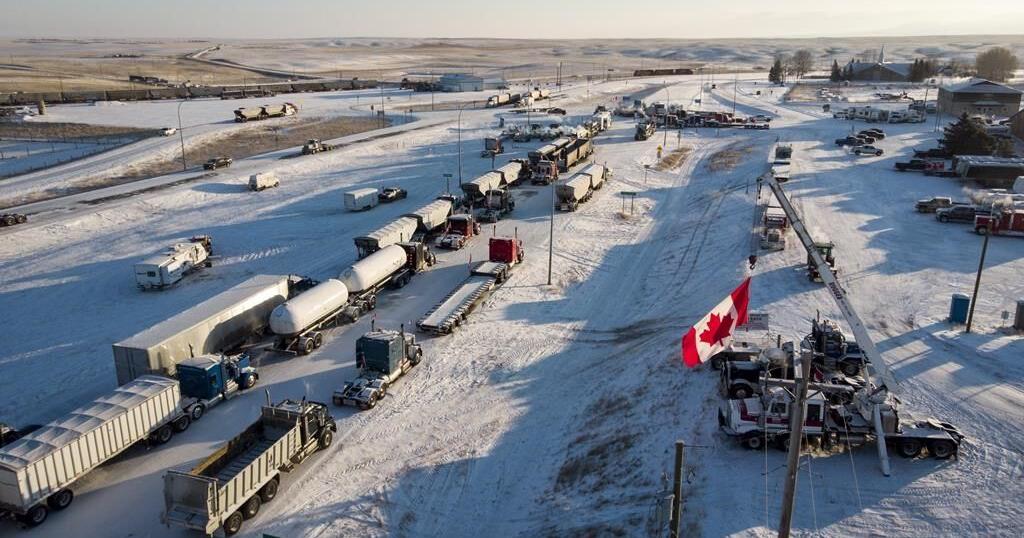LETHBRIDGE, Alta. – The COVID-19 blockade at Coutts, Alta., drew on support from a cross-section of people, including a country musician who jumped at the chance to perform “Freedom” at the barricade, a courtroom heard Monday.
Lyndsay Butler testified she performed at the 2022 protest at the Canada-U.S. border crossing and later struck up a long-distance friendship with Anthony Olienick.
Olienick and Chris Carbert are on trial charged with conspiracy to commit murder of Mounties at the blockade.
Butler told court that when the pandemic started in 2020, her music career slammed to a halt. When she tried to get it going again the next year, COVID-19 rules and vaccine mandates slammed her again.
“A company that was doing the outdoor performances … they changed their policy in September of 2021,” she testified Monday in court in Lethbridge, Alta.
“They needed to know our private medical information, as in vaccination status, if we were to be left on the roster to be able to work.”
“How often were you able to work?” asked Marilyn Burns, the lawyer representing Olienick.
“No longer with that company, as I wouldn’t provide them with that information,” Butler replied.
Butler, who lived near Okotoks, south of Calgary, at the time, said she was excited when she was invited to the protest.
“I was asked by a friend if I would head down and sing.”
Butler said she performed there twice. The last time on Feb. 12, on a portable stage, she sang “Bound to Come Out” as well as “Freedom.”
She said she was introduced to Olienick and over the past year became friends with his family. She wrote him letters while he was in custody.
“We’ve been corresponding. I would say three to five (letters) to Anthony,” she said during cross-examination by the Crown.
“I would guess he’s called me eight times,” she said.
“We talked a lot about dogs. We talked about farming and how the crops were looking. I took it on as my duty to bring real life back in their non-lives.”
Butler said she has also helped Olienick’s elderly mother at the family’s farm near Claresholm and sang at her 80th birthday.
“I just thought I would like to help Tessie, (she) being an older lady, taking care of an entire farm. I could be there quite often during the week to help cut grass, water trees, helping with driving to visits where Tony was in Lethbridge or Medicine Hat,” she said.
Butler said she also wrote Carbert and received one response.
The Crown has introduced police testimony and weapons evidence to argue the accused were intent on killing Mounties to keep the blockade intact.
Undercover officers have testified Olienick told them he believed police were pawns of government and that if officers came to the blockade he would “slit their throats.”
Burns has told the jury Olienick was part of a group who believed they had a responsibility to act against the razor’s edge of a totalitarian government seeking to end fundamental individual freedoms.
Another defence witness was Travis Lonsberry, a trucker from near High River. He told court he was still employed but wanted to help.
“I’d kind of been watching stuff to do with the convoys going on. And then when I heard they blocked the border, I thought I kind of needed to show my support,” he said.
“I’d go down on the weekends if I could. I thought it was important.”
The protest tied up cross-border traffic for two weeks and ended peacefully when police made arrests and seized weapons, ammunition and body armour near the site.
They also recovered 40,000 rounds of ammunition along with a shotgun, a rifle and two pipe bombs at Olienick’s acreage.
Grant Lobban, a friend of Olienick, told court Monday he had a truck stored on the property and had a rifle and a shotgun inside. He said the two weapons belonged to him.
Brian Lambert said at one point he employed Olienick to run his sandstone quarry. He said he witnessed Olienick use what he called “little firecrackers” to break off pieces of stone.
“You make them out of ordinary plumbing pipe and use some kind of propellant like shotgun powder or something like that,” Lambert said.
“It depended on how big a hole or how large a piece of stone you were going to crack. The one I saw was about six inches long … maybe an inch in diameter.
He said the firecracker had a fireworks fuse.
“You can find them at any hobby store,” he said.
This report by The Canadian Press was first published July 15, 2024.
— By Bill Graveland in Calgary

























